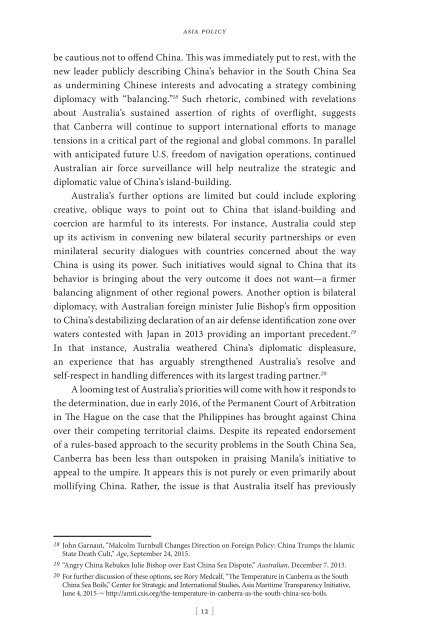You also want an ePaper? Increase the reach of your titles
YUMPU automatically turns print PDFs into web optimized ePapers that Google loves.
asia policy<br />
be cautious not to offend China. This was immediately put to rest, with the<br />
new leader publicly describing China’s behavior in the South China Sea<br />
as undermining Chinese interests and advocating a strategy combining<br />
diplomacy with “balancing.” 18 Such rhetoric, combined with revelations<br />
about Australia’s sustained assertion of rights of overflight, suggests<br />
that Canberra will continue to support international efforts to manage<br />
tensions in a critical part of the regional and global commons. In parallel<br />
with anticipated future U.S. freedom of navigation operations, continued<br />
Australian air force surveillance will help neutralize the strategic and<br />
diplomatic value of China’s island-building.<br />
Australia’s further options are limited but could include exploring<br />
creative, oblique ways to point out to China that island-building and<br />
coercion are harmful to its interests. For instance, Australia could step<br />
up its activism in convening new bilateral security partnerships or even<br />
minilateral security dialogues with countries concerned about the way<br />
China is using its power. Such initiatives would signal to China that its<br />
behavior is bringing about the very outcome it does not want—a firmer<br />
balancing alignment of other regional powers. Another option is bilateral<br />
diplomacy, with Australian foreign minister Julie Bishop’s firm opposition<br />
to China’s destabilizing declaration of an air defense identification zone over<br />
waters contested with Japan in 2013 providing an important precedent. 19<br />
In that instance, Australia weathered China’s diplomatic displeasure,<br />
an experience that has arguably strengthened Australia’s resolve and<br />
self-respect in handling differences with its largest trading partner. 20<br />
A looming test of Australia’s priorities will come with how it responds to<br />
the determination, due in early 2016, of the Permanent Court of Arbitration<br />
in The Hague on the case that the Philippines has brought against China<br />
over their competing territorial claims. Despite its repeated endorsement<br />
of a rules-based approach to the security problems in the South China Sea,<br />
Canberra has been less than outspoken in praising Manila’s initiative to<br />
appeal to the umpire. It appears this is not purely or even primarily about<br />
mollifying China. Rather, the issue is that Australia itself has previously<br />
18 John Garnaut, “Malcolm Turnbull Changes Direction on Foreign Policy: China Trumps the Islamic<br />
State Death Cult,” Age, September 24, 2015.<br />
19 “Angry China Rebukes Julie Bishop over East China Sea Dispute,” Australian, December 7, 2013.<br />
20 For further discussion of these options, see Rory Medcalf, “The Temperature in Canberra as the South<br />
China Sea Boils,” Center for Strategic and International Studies, Asia Maritime Transparency Initiative,<br />
June 4, 2015 u http://amti.csis.org/the-temperature-in-canberra-as-the-south-china-sea-boils.<br />
[ 12 ]


